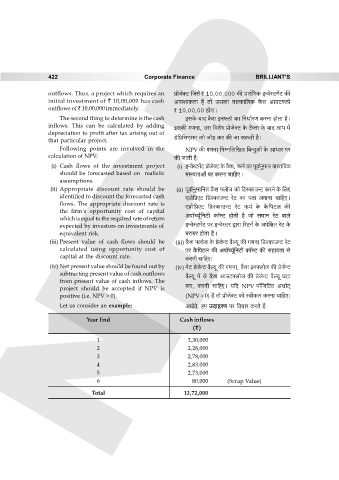Page 422 - Corporate Finance PDF Final new link
P. 422
NPP
422 Corporate Finance BRILLIANT’S
outflows. Thus, a project which requires an àmoOoŠQ> {Ogo ` 10,00,000 H$s àma§{^H$ BÝdoñQ>_|Q> H$s
initial investment of ` 10,00,000 has cash Amdí`H$Vm h¡ Vmo CgH$m VmËH$m{cH$ H¡$e AmCQ>âcmo
outflows of ` 10,00,000 immediately. ` 10,00,00 hmoJmŸ&
The second thing to determine is the cash BgHo$ ~mX H¡$e BZâcmo H$m {ZYm©aU H$aZm hmoVm h¡Ÿ&
inflows. This can be calculated by adding BgH$s JUZm, Cg {deof àmoOoŠQ> Ho$ Q>¡Šg Ho$ ~mX cm^ _|
depreciation to profit after tax arising out of
that particular project. S>o{à{gEeZ H$mo Omo‹S> H$a H$s Om gH$Vr h¡Ÿ&
Following points are involved in the NPV H$s JUZm {ZåZ{b{IV {~ÝXwAm| Ho$ AmYma na
calculation of NPV: H$s OmVr h¡:
(i) Cash flows of the investment project (i) BÝdoñQ>_|Q> àmoOoŠQ> Ho$ H¡$e, âbmo H$m nydm©Zw_mZ dmñV{dH$
should be forecasted based on realistic _mÝ`VmAm| na H$aZm Mm{hEŸ&
assumptions.
(ii) Appropriate discount rate should be (ii) nydm©Zw_m{ZV H¡$e âbmoO H$mo {S>ñH$mCÝQ> H$aZo Ho$ {bE
identified to discount the forecasted cash Eàmo{n«EQ> {S>ñH$mCÝQ> aoQ> H$m nVm bJmZm Mm{hEŸ&
flows. The appropriate discount rate is Eàmo{àEQ> {S>ñH$mCÝQ> aoQ> \$_© Ho$ H¡${nQ>b H$s
the firm's opportunity cost of capital
which is equal to the required rate of return Anm°À`y©{ZQ>r H$m°ñQ> hmoVr h¡ Omo g_mZ aoQ> dmbo
expected by investors on investments of BÝdoñQ>_|Q> na BÝdoñQ>a Ûmam {aQ>Z© Ho$ Ano{jV aoQ> Ho$
equivalent risk. ~am~a hmoVm h¡Ÿ&
(iii) Present value of cash flows should be (iii) H¡$e âbmoO Ho$ àoOoÝQ> d¡ë`y H$s JUZm {S>ñH$mCÝQ> aoQ>
calculated using opportunity cost of na H¡${nQ>b H$s Anm°À`y©{ZQ>r H$m°ñQ> H$s ghm`Vm go
capital at the discount rate. H$aZr Mm{hE&
(iv) Net present value should be found out by (iv) ZoQ> àoOoÝQ> d¡ë`y H$s JUZm, H¡$e BZâbmoO H$s àoOoÝQ>
subtracting present value of cash outflows
d¡ë`y _| go H¡$e AmCQ>âbmoO H$s àoOoÝQ> d¡ë`y KQ>m
from present value of cash inflows. The
H$a, H$aZr Mm{hEŸ& `{X NPV nm°{O{Q>d AWm©V²
project should be accepted if NPV is
positive (i.e. NPV > 0). (NPV > 0) h¡ Vmo àmoOoŠQ> H$mo ñdrH$ma H$aZm Mm{hE&
Let us consider an example: AmB©¶o, h‘ CXmhaU na {dMma H$aVo h¢:$
Year End Cash inflows
(`)
1 2,30,000
2 2,28,000
3 2,78,000
4 2,83,000
5 2,73,000
6 80,000 (Scrap Value)
Total 13,72,000

